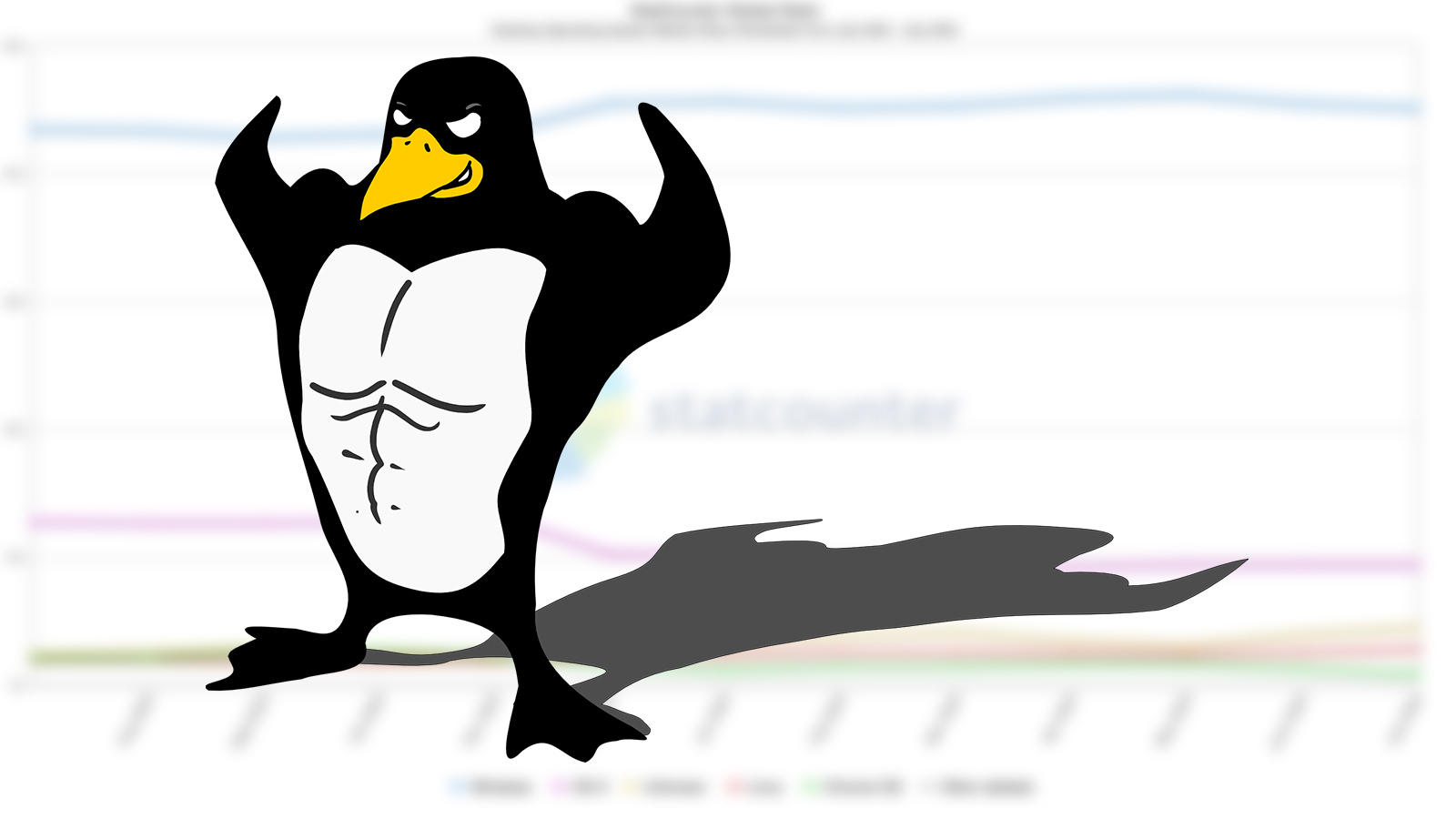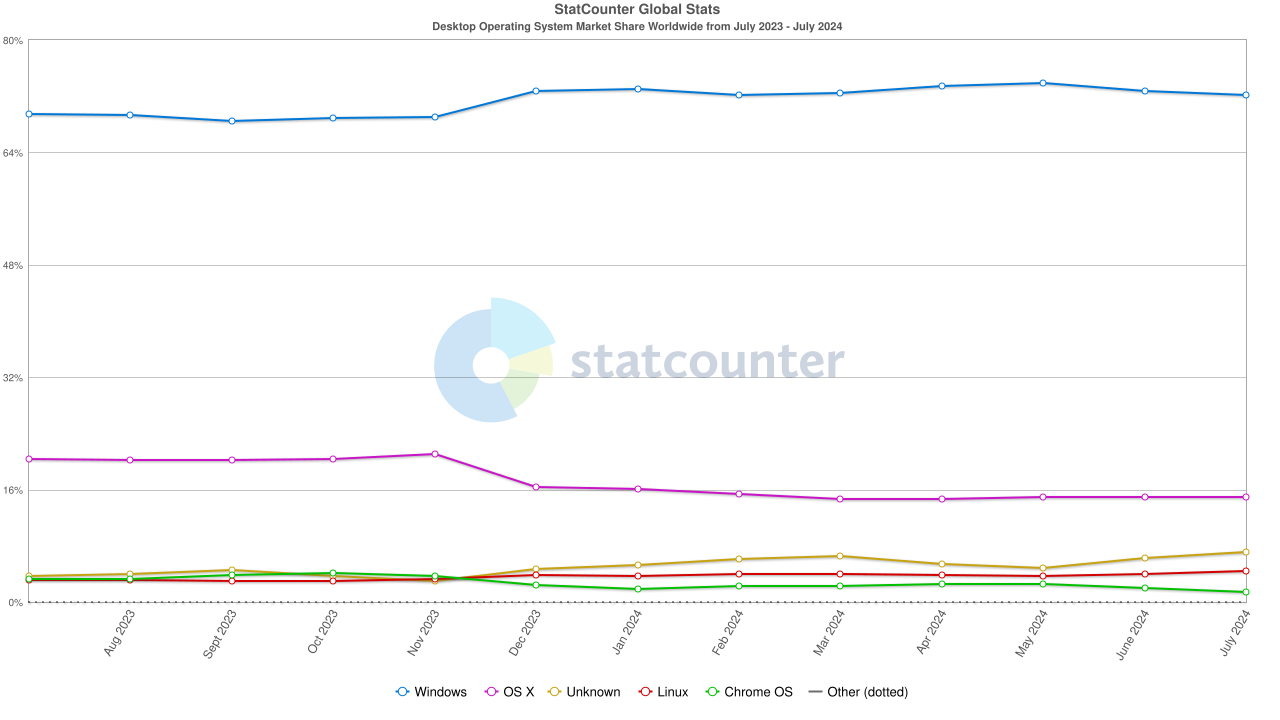Linux market share approaching 4.5% for first time, could hit 5% by 1Q25
Linux is an increasingly popular alternative to Windows and macOS.

Global analytics company StatCounter shows that the Linux market share of desktop operating systems has hit an all-time high of 4.44%, up from 3.12% a year ago, and it was just 2.76% in July 2022. While this might look like a small amount, this is a massive jump in terms of real numbers, especially as most Linux distributions are essentially free and have no marketing teams behind them.
The Linux operating system first breached the 4% mark in February 2024 but slumped back down to less than 3.9% in April and May. It recovered to 4.05% in June before hitting its record high of 4.44% this July. But if we look at Linux’s previous numbers, the operating system is on track to hit a 5% market share by February 2025, if the trend continues.

Many consumers may not have seriously considered using Linux as their daily driver operating system. However, this OS is widely used in many corporate IT systems because of its flexibility, openness, and affordability, with a wide range of general-purpose and specialized distros available for free. Aside from that, Microsoft is making it harder to install Windows 11 with a local account and you can no longer bypass the Windows 11 TPM 2.0 requirement, thus potentially turning off users who are considering upgrading from Windows 10 but do not have compatible hardware.
Since macOS is a rather expensive alternative to Windows, especially as you need the corresponding hardware to use it, many are discovering the joy of using Linux. This is especially true as Linux has been around for several decades already, and that it has received continuous improvements from a dedicated and passionate fan base. In fact, the operating system recently received a one-line kernel patch that sped up boot time by 0.035 seconds. Because of this, you can find several free but user-friendly distros.
Steam’s investment in the Linux operating system for the Steam Deck handheld is also driving the growth of this operating system in the gaming space. In fact, the Steam Survey report for June 2024 showed that Linux finally broke above the 2% market share. This is significant as Steam Survey is more likely to focus on consumer (gaming) PCs, as you’re unlikely to put Steam in a corporate PC.
With some users unhappy with how Microsoft is slowly turning Windows from an operating system into a software-as-a-service product and can’t stomach Apple’s walled garden approach, more and more are turning to Linux to serve as their primary operating system. As we get more apps working with it, we might someday see the operating system capture a significant chunk of the market and have widespread consumer use.
Stay On the Cutting Edge: Get the Tom's Hardware Newsletter
Get Tom's Hardware's best news and in-depth reviews, straight to your inbox.

Jowi Morales is a tech enthusiast with years of experience working in the industry. He’s been writing with several tech publications since 2021, where he’s been interested in tech hardware and consumer electronics.
-
ET3D I find these figures highly suspect and would be interested in learning how they're gathered.Reply -
coolitic Reply
Why do you find them to be suspicious?ET3D said:I find these figures highly suspect and would be interested in learning how they're gathered. -
Heat_Fan89 Reply
IIRC, SteamOS is based on Linux and that's what the Steam Deck runs on. So it's possible those numbers might help with Linux's market share numbers. Also Linux has become more popular as Linux distributions embrace those with limited knowledge of Linux. The average user can use Linux now for the basics.TheSecondPower said:Why the sudden rise? Does the Steam Deck make up like 90% of Linux devices? -
spiffyshoes Reply
I not sure if sudden rise is the term. I would use. It has been gaining about 1% every year since the steam deck came out. I was one of the people who switched. I had always avoided switching because of lack of gaming support. Steam the app now runs very well on Linux desktop and Linux has gotten easier to use. I use my computer to game, 3d print, and surf the web and it does these things very well for me. Obviously 4.5% is still a tiny market share. Look forward to when Cosmic Desktop becomes stable.TheSecondPower said:Why the sudden rise? Does the Steam Deck make up like 90% of Linux devices? -
ezst036 Reply
It's not sudden. It's been a steady drum beat for a while now.TheSecondPower said:Why the sudden rise? Does the Steam Deck make up like 90% of Linux devices?
(July 12, 2023)
https://www.tomshardware.com/news/linux-hits-3-percent-client-pc-market-share
https://arstechnica.com/gadgets/2024/03/linux-continues-growing-market-share-reaches-4-of-desktops/ -
Gravy405 Pop os here. No drivers no problems. I ditched windows 5 years ago and not looking back. My 86 yo mother uses POP os on her pc.Reply -
TheSecondPower If most of that growth is the Steam Deck, then about half of the Linux market is for gamers. And probably half of the Windows market isn't. And developers that don't want to support 2 platforms are avoiding the 15% of the market that has MacOS, so that 4.5% is more like 6% of the available make market. Most games just work on the Steam Deck. For the rest, it's likely that a small change could translate into around 6% more revenue. That's potentially a big deal.Reply
I suspect most of that market is controller-friendly games. So if you're making a controller game, then targetting Linux will be more lucrative, whereas mouse and keyboard games will be less. -
Gravy405 Between Pop using Steam, Gog and Heroic I have yet to find a game that wont run. Just don't use flatpack steam install.Reply